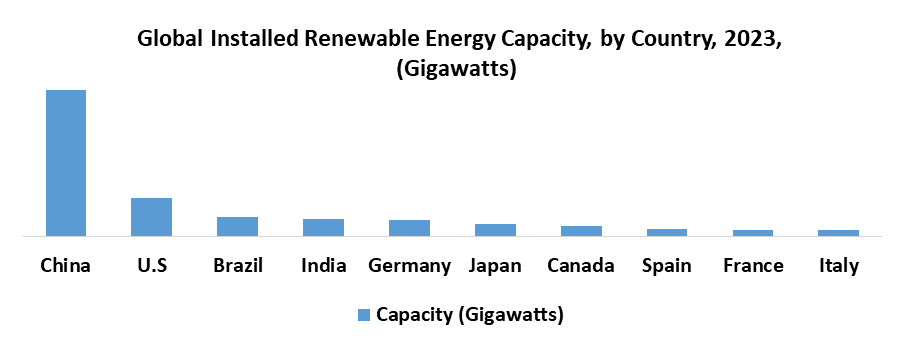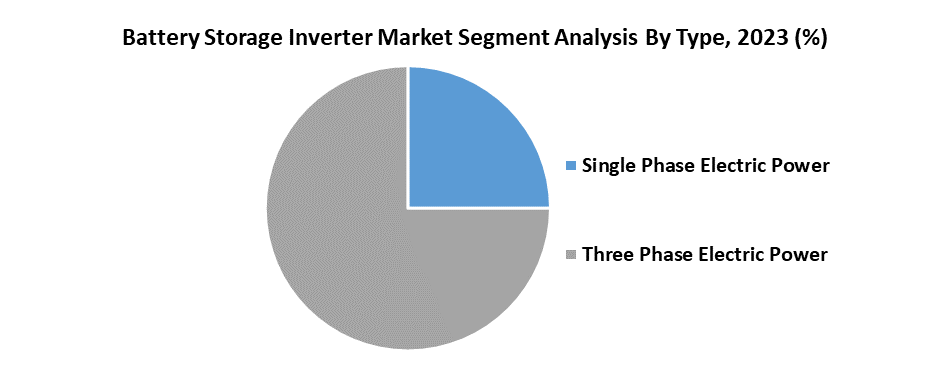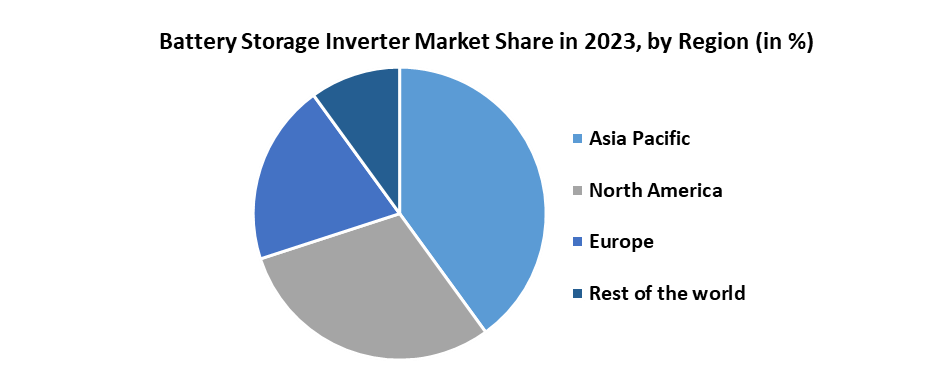Battery Storage Inverter Market: Global Industry Analysis and Forecast (2024-2030)
The Battery Storage Inverter Market size was valued at USD 2.9 Bn. in 2023 and the total Global Battery Storage Inverter revenue is expected to grow at a CAGR of 9% from 2024 to 2030, reaching nearly USD 5.51 Bn. by 2030.
Format : PDF | Report ID : SMR_2128
Battery Storage Inverter Market Overview
Battery storage inverters, also known as battery inverters or hybrid inverters, are devices used in energy storage systems to convert direct current (DC) electricity from batteries into alternating current (AC) electricity, which is the type of electricity used in most electrical systems.
- According to SMR, China, India, and Vietnam are the top 3 exporters of the battery storage inverters.
The comprehensive report by Stellar Market Research provides an in-depth analysis of the Battery Storage Inverter Market with a focus on predicting market growth trends. It offers valuable insights into the dynamics of the value chain and the supply chain. By analysing the scope of the Battery Storage Inverter Market, this report provides a detailed understanding of the complex network of processes and stakeholders that are involved in the production and distribution of these inverters. The research objective is to gain a better understanding of the current landscape of types and users of battery storage inverters.
The report emphasizes the significance of import and export activities in the Battery Storage Inverter market since they ensure continuous transactions between suppliers and end-users. Key players play a crucial role in driving innovation and improving product efficacy, underscoring the importance of targeted strategies to meet evolving demands. Additionally, the analysis assesses the cost-profit ratio, which enables the evaluation of companies' financial capabilities for investing in research and development aimed at introducing new products or improving existing ones.
The growth and innovation of the market are driven by opportunities in new product development and advancements in technologies. The report offers statistical data on the effectiveness of Battery Storage inverters in various industries and its impact on market trends through quantitative research methods. Competitive intelligence analysis helps to understand market dynamics, competitor strategies, and customer perceptions, providing market players with a competitive advantage in the global Battery Storage Inverter market.
To get more Insights: Request Free Sample Report
Battery Storage Inverter Market Dynamics
Battery Storage Inverters Powering the Renewable Energy Future
Governments globally are enacting policies and offering incentives to reduce carbon emissions and encourage sustainable energy solutions. For instance, the objective of the European Union is to decrease greenhouse gas emissions by at least 55% by 2030, while the United States aims for a carbon-free electricity sector by 2035. Such ambitious goals require substantial investments in renewable energy infrastructure, including battery storage systems that improve the efficiency and reliability of solar and wind power further driving the battery storage inverter market. The rise in electric vehicle (EV) adoption also contributes to this trend as the global EV sales saw a 35% increase in 2023, indicating a growing demand for energy storage solutions capable of supporting the electric grid and charging infrastructure.
Additionally, advancements in battery technology have led to an approximate 82% decrease in lithium-ion battery costs over the past decade, making battery storage solutions more economically feasible. This cost reduction, along with enhancements in inverter efficiency and performance, enhances the appeal of integrating battery storage with renewable energy systems further increasing the need for the battery storage inverter market. Leading this transition, countries like China, which derived 32% of its electricity from renewable sources in 2020, are creating significant opportunities for the battery storage inverter market.
Similarly, India aims to achieve 170 GW of renewable energy capacity by 2025, emphasizing the importance of efficient energy storage solutions. As the penetration of renewable energy increases, the demand for stable and reliable grid operations grows, boosting the need for an advanced battery storage inverter market. These inverters play a vital role in managing energy flow, maintaining grid stability, and ensuring seamless integration of intermittent renewable sources. The global focus on lowering carbon footprints, combined with technological progress and policy support, is driving the battery storage inverter market, positioning it as a critical enabler in the transition to a sustainable energy future.
- According to SMR, in 2023, the global clean energy sources accounted for over 39 percent of electricity generation, up from a 397 percent share a year earlier.

Environmental Threats Posed by Improper Battery Disposal
Improper disposal of batteries, especially lithium-ion types, causes significant harm to the environment by contaminating soil and water. These batteries contain harmful metals like lead, cadmium, and mercury. When not disposed of properly, these metals seep into the environment, leading to serious health and ecological consequences. For instance, a single lithium-ion battery has the potential to pollute up to 60,000 liters of water, posing a severe threat to human health and aquatic life. Poor handling of these batteries also results in fires and explosions, leading to hazardous waste and increased pollution. The Americans throw away about 3 billion batteries totaling more than 180,000 tons of waste, highlighting the scale of the problem. However, only 5% of lithium-ion batteries are recycled correctly, indicating a significant gap in the management of end-of-life battery disposal.
Regulatory frameworks in many countries are still developing and are struggling to keep up with the rapid adoption of battery storage systems, further worsening the issue. For instance, Industrial batteries (including EV batteries) are completely banned from landfills in Europe and the US, which means that they should be handed over to a processor of hazardous waste. The environmental risks associated with battery disposal create a major obstacle for the market, as stakeholders strive to balance the benefits of energy storage with the need for sustainable and safe disposal practices.
This growing concern not only impacts market dynamics but also influences consumer and investor confidence, as environmental sustainability becomes an increasingly critical factor in decision-making processes. The battery storage inverter market needs to address these intricate environmental challenges to ensure long-term viability and acceptance in a world increasingly focused on green energy solutions.
Battery Storage Inverter Market Segment Analysis
By Type, According to SMR research, the Three Phase Electric Power segment has been the largest and dominated the Battery Storage Inverter Market in 2023. Three-phase inverters have established themselves as the industry standard as more commercial and industrial operations demand strong and reliable electrical solutions. The effective power distribution, decreased power imbalances, and improved overall system stability of these systems are advantageous to large facilities further increasing the demand for the three-phase electric power segment in the global battery storage inverter market. In particular, three-phase inverters are essential for the seamless integration of solar and wind energy into the power system in renewable energy applications.
They offer high levels of efficiency, sometimes around 95%, which is essential for improving energy use and cutting down on operating costs. Additionally, they are versatile and have been used with several kinds of batteries, including lead-acid and lithium-ion, which makes them more appropriate for a range of energy storage situations. Three-phase inverter deployment has risen in regions like North America and Europe where stringent regulations demand good power quality and dependability. Also, these systems are capable of larger power ratings; certain versions allow for capacities greater than 500 kW, which makes them ideal for large-scale energy storage projects.
The segment dominance in the battery storage inverter market is further solidified by their capacity to handle both on- and off-grid applications, which cater to the demands of various industries including data centers and manufacturing. As the demand for global energy increases, the Three Phase Electric Power segment is expected to maintain its dominance in the global battery storage inverter market.

Battery Storage Inverter Market Regional Analysis
The Asia-Pacific region dominated the global battery storage inverters market as a result of the rapid growth in population and industrialization, which has significantly increased energy consumption. The necessity for efficient energy storage systems is demonstrated by the 4.7% yearly rise in China's power consumption. The increase in energy demand is being met by the widespread use of battery storage inverters in utility-scale, commercial, and residential applications driving the battery storage inverter market. Battery storage inverters have been widely used by China's State System Corporation to improve system stability and include renewable energy sources like solar and wind.
A 150MW/194MWh plant in Australia called Hornsdale Power Reserve demonstrates quick frequency to regulate improving grid stability. Energy storage technology has advanced in South Korea and Japan as a result of large expenditures on renewable energy projects and robust research and development further increasing the demand for the battery storage inverter market. The market dominance continues to be strengthened by government initiatives. For instance, 420MW of solar, wind, and battery storage are combined in India's hybrid renewable energy projects, which are crucial for guaranteeing a steady supply of electricity.

Additionally, the need for backup power solutions is being driven by an increase in power outages in areas with poor electrical infrastructure, which is further driving up the battery storage inverter market. Battery storage inverters are now more dependable, efficient, and reasonably priced because of technological developments fueled by research and development in nations like South Korea and Japan. In response to the region's emphasis on identifying the energy storage supply chain, there is a decreased reliance on imports, which encourages self-sufficiency and maintains sector growth. The Asia-Pacific dominated the global battery storage inverter market given to its fast-increasing energy consumption, large expenditures in renewable energy, advantageous legislation, cost benefits, and technical breakthroughs.
Battery Storage Inverter Market Competitive Landscape
The Global Battery Storage Inverter Market industry is competitive among companies owing to numerous players. The major players in the market include etc. These companies are pushing boundaries, investing in research and development to expand their product lines, and undertaking strategic activities including new product launches, contractual agreements, mergers and acquisitions, and collaborations with other organizations.
- In 2024, GoodWe unveiled the Lynx C, a 60 kWh outdoor battery system for commercial and industrial PV applications. It features a compartment for the company's ET15-30kW inverter series, forming a complete energy storage solution.
- In 2023, SMA Solar Technology AG announced a partnership with BYD to offer the BYD Premium HVL Battery Box as part of its SMA Home Energy Solution. The battery enables intermediate storage of unused solar energy and makes it available on demand.
- In 2023, Huawei partnered with Alternergy, a UK-based solar company, to offer pre-configured bundles of Huawei's single-phase inverters paired with the LUNA2000 battery system in capacities ranging from 5 kWh to 15 kWh.
|
Battery Storage Inverter Market Scope |
|
|
Market Size in 2023 |
USD 2.9 Bn. |
|
Market Size in 2030 |
USD 5.51 Bn. |
|
CAGR (2024-2030) |
9 % |
|
Historic Data |
2018-2022 |
|
Base Year |
2023 |
|
Forecast Period |
2024-2030 |
|
|
By Type Single-Phase Electric Power Three-Phase Electric Power |
|
|
By End Use Industry Residential Commercial & Industrial Utility Sector |
|
Regional Scope |
North America- United States, Canada, and Mexico Europe – UK, France, Germany, Italy, Spain, Sweden, Austria, and Rest of Europe Asia Pacific – China, India, Japan, South Korea, Australia, ASEAN, Rest of APAC Middle East and Africa - South Africa, GCC, Egypt, Nigeria, Rest of the Middle East and Africa South America – Brazil, Argentina, Rest of South America |
Key Player in the Battery Storage Inverter Market
- SMA Solar Technology AG (Germany)
- GoodWe (China)
- Ingeteam (Spain)
- Sungrow Power (China)
- Huawei Technologies (China)
- Ginlong Technologies (Solis) (China)
- Growatt New Energy (China)
- SMA Solar Technology AG (Germany)
- GoodWe (China)
- Power Electronics (Spain)
- Sineng Electric (China)
- SolarEdge (Israel)
- TMEIC (USA)
- Fimer (Italy)
- SofarSolar (China)
- TBEA (China)
- Enphase Energy (USA)
- Hisen Power (China)
- Dynapower (USA)
- Parker (USA)
- Schneider Electric (France)
- Fronius (Austria)
Frequently Asked Questions
The high initial cost of installing battery storage solutions and Environmental concerns around the proper disposal of batteries used in storage systems are the challenges in the Battery Storage Inverter market.
The Asia Pacific region is expected to dominate the market share throughout the forecasted period.
The Market size was valued at USD 2.9 Billion in 2023 and the total Market revenue is expected to grow at a CAGR of 9 % from 2024 to 2030, reaching nearly USD 5.51 billion.
The segments covered in the market report are Type, End-Use Industry, and region.
1. Battery Storage Inverter Market: Research Methodology
2. Battery Storage Inverter Market: Executive Summary
3. Battery Storage Inverter Market: Competitive Landscape
4. Potential Areas for Investment
4.1. Stellar Competition Matrix
4.2. Competitive Landscape
4.3. Key Players Benchmarking
4.4. Market Structure
4.4.1. Market Leaders
4.4.2. Market Followers
4.4.3. Emerging Players
4.5. Consolidation of the Market
5. Battery Storage Inverter Market: Dynamics
5.1. Market Trends
5.2. Market Drivers
5.3. Market Restraints
5.4. Market Opportunities
5.5. Market Challenges
5.6. PORTER’s Five Forces Analysis
5.7. PESTLE Analysis
5.8. Value Chain Analysis
5.9. Strategies for New Entrants to Penetrate the Market
5.10. Regulatory Landscape by Region
5.10.1. North America
5.10.2. Europe
5.10.3. Asia Pacific
5.10.4. Middle East and Africa
5.10.5. South America
5.11. Global Import Export Analysis
6. Battery Storage Inverter Market Size and Forecast by Segments (by Value USD Billion)
6.1. Battery Storage Inverter Market Size and Forecast, by Type (2023-2030)
6.1.1. Single-Phase Electric Power
6.1.2. Three-Phase Electric Power
6.2. Battery Storage Inverter Market Size and Forecast, by End-Use Industry (2023-2030)
6.2.1. Residential
6.2.2. Commercial
6.2.3. Utility Sector
6.3. Battery Storage Inverter Market Size and Forecast, by Region (2023-2030)
6.3.1. North America
6.3.2. Europe
6.3.3. Asia Pacific
6.3.4. Middle East and Africa
6.3.5. South America
7. North America Battery Storage Inverter Market Size and Forecast (by Value USD Billion)
7.1. North America Battery Storage Inverter Market Size and Forecast, by Type (2023-2030)
7.1.1. Single-Phase Electric Power
7.1.2. Three-Phase Electric Power
7.2. North America Battery Storage Inverter Market Size and Forecast, by End-Use Industry (2023-2030)
7.2.1. Residential
7.2.2. Commercial
7.2.3. Utility Sector
7.3. North America Battery Storage Inverter Market Size and Forecast, by Country (2023-2030)
7.3.1. United States
7.3.2. Canada
7.3.3. Mexico
8. Europe Battery Storage Inverter Market Size and Forecast (by Value USD Billion)
8.1. Europe Battery Storage Inverter Market Size and Forecast, by Type (2023-2030)
8.1.1. Single-Phase Electric Power
8.1.2. Three-Phase Electric Power
8.2. Europe Battery Storage Inverter Market Size and Forecast, by End-Use Industry (2023-2030)
8.2.1. Residential
8.2.2. Commercial
8.2.3. Utility Sector
8.3. Europe Battery Storage Inverter Market Size and Forecast, by Country (2023-2030)
8.3.1. UK
8.3.2. France
8.3.3. Germany
8.3.4. Italy
8.3.5. Spain
8.3.6. Sweden
8.3.7. Austria
8.3.8. Rest of Europe
9. Asia Pacific Battery Storage Inverter Market Size and Forecast (by Value USD Billion)
9.1. Asia Pacific Battery Storage Inverter Market Size and Forecast, by Type (2023-2030)
9.1.1. Single-Phase Electric Power
9.1.2. Three-Phase Electric Power
9.2. Asia Pacific Battery Storage Inverter Market Size and Forecast, by End-Use Industry (2023-2030)
9.2.1. Residential
9.2.2. Commercial
9.2.3. Utility Sector
9.3. Asia Pacific Battery Storage Inverter Market Size and Forecast, by Country (2023-2030)
9.3.1. China
9.3.2. S Korea
9.3.3. Japan
9.3.4. India
9.3.5. Australia
9.3.6. Indonesia
9.3.7. Malaysia
9.3.8. Vietnam
9.3.9. Taiwan
9.3.10. Bangladesh
9.3.11. Pakistan
9.3.12. Rest of Asia Pacific
10. Middle East and Africa Battery Storage Inverter Market Size and Forecast (by Value USD Billion)
10.1. Middle East and Africa Battery Storage Inverter Market Size and Forecast, by Type (2023-2030)
10.1.1. Single-Phase Electric Power
10.1.2. Three-Phase Electric Power
10.2. Middle East and Africa Battery Storage Inverter Market Size and Forecast, by End-Use Industry (2023-2030)
10.2.1. Residential
10.2.2. Commercial
10.2.3. Utility Sector
10.3. Middle East and Africa Electric Vehicle Traction Motor Market Size and Forecast, by Country (2023-2030)
10.3.1. South Africa
10.3.2. GCC
10.3.3. Egypt
10.3.4. Nigeria
10.3.5. Rest of ME&A
11. South America Battery Storage Inverter Market Size and Forecast (by Value USD Billion)
11.1. South America Battery Storage Inverter Market Size and Forecast, by Type (2023-2030)
11.1.1. Single-Phase Electric Power
11.1.2. Three-Phase Electric Power
11.2. South America Battery Storage Inverter Market Size and Forecast, by End-Use Industry (2023-2030)
11.2.1. Residential
11.2.2. Commercial
11.2.3. Utility Sector
11.3. South America Battery Storage Inverter Market Size and Forecast, by Country (2023-2030)
11.3.1. Brazil
11.3.2. Argentina
11.3.3. Rest of South America
12. Company Profile: Key players
12.1. SMA Solar Technology AG
12.1.1. Company Overview
12.1.2. Financial Overview
12.1.3. Business Portfolio
12.1.4. SWOT Analysis
12.1.5. Business Strategy
12.1.6. Recent Developments
12.2. GoodWe
12.3. Ingeteam
12.4. Sungrow Power
12.5. Huawei Technologies
12.6. Ginlong Technologies (Solis)
12.7. Growatt New Energy
12.8. SMA Solar Technology AG
12.9. GoodWe
12.10. Power Electronics
12.11. Sineng Electric
12.12. SolarEdge
12.13. TMEIC
12.14. Fimer
12.15. SofarSolar
12.16. TBEA
12.17. Enphase Energy
12.18. Hisen Power
12.19. Dynapower
12.20. Parker
12.21. Schneider Electric
12.22. Fronius
13. Key Findings
14. Analyst Recommendations
















